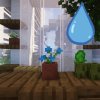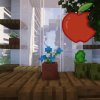FuzzyChinchilla
Level 2
Photo By: Sumi Ishida
Since Spring has rolled around the corner, and we’re beginning to see the Cherry blossom trees bloom, we can all appreciate the beauty of nature around us. In order to preserve these wonders, I’d like to highlight a topic you all likely have heard of in science class:
~ The Environment ~
Taking care of our environment is of vital importance, as the plants around us provide us with clean air to breathe, filtering toxins, our ‘carbon footprint’ influences extreme weather events, and waste and use of resources affects the ecosystems we live in.
For today, we will be breaking the topic down into 5 sectors: Renewable Energy, Transportation, Forestry and Wildlife, Littering, and Plant Care.
~ The Environment ~
Taking care of our environment is of vital importance, as the plants around us provide us with clean air to breathe, filtering toxins, our ‘carbon footprint’ influences extreme weather events, and waste and use of resources affects the ecosystems we live in.
For today, we will be breaking the topic down into 5 sectors: Renewable Energy, Transportation, Forestry and Wildlife, Littering, and Plant Care.
Renewable Energy:
Renewable Energy:
Photo By: Kenma Kamui
You may have heard the term ‘Renewable Energy’ before, but what does this mean? Well, renewable energy refers to sources we use for electricity that won’t deplete over time. Some examples of such sources are hydro-electricity, solar-power, and wind turbines. The contrasting term would be ‘Non-Renewable Energy’. This refers to finite resources that get used up over time. Some examples of non-renewable energy are the burning of fossil fuels, such as coal or oil, and nuclear-energy.
To gain some more clarity on Karakura’s goals for our own electric system, and energy resources, I had a chat with our very own Mayor: Annabell Sturm
To gain some more clarity on Karakura’s goals for our own electric system, and energy resources, I had a chat with our very own Mayor: Annabell Sturm
Sumi Ishida - “To begin, there are some visible power generation systems in Karakura, such as the solar panels on many apartment complexes, and the now inactive nuclear fission plant. What energy resources do you think have the most potential in the future for Karakura? Hydro, Solar, Wind, Fission, Geothermal, Coal, etcetera?”
Annabell Sturm - “Well, most of the world is attempting to move away from power generation through coal and such. Especially in Karakura, I believe a hydro plant would show most efficient. Along side with solar and wind.”
Sumi Ishida - “Additionally, is the resiliency of Karakura’s electric system a concern at all given the recent extreme weather events we’ve been seeing?”
Annabell Sturm - “Well, we make sure that even with weather conditions, that all electrical systems stay online - and how to improve stability. If it’s knocked down, we search for the best method of repair, to hinder such an occurrence.”
Sumi Ishida - “Sounds like a very well thought-out system. What are your thoughts on renewable energy? How important do you think it is that green energy, or rather, environmentally friendly energy sources, are focused on in the future?”
Annabell Sturm - “As a single city, we can’t change the course of the use of renewable energy much, but I believe it is one the topics we should be focusing on. It is our job to keep our planet and environment healthy, as its health benefits us as well.”
Sumi Ishida - “What is the best way for students, as they become more interested and concerned with the environment, to communicate what sort of advancements they’d like to see in their community?”
Annabell Sturm - “They can always come here and interact with Governors, the Deputy Mayor, and even me, if we’re not busy. It is important that students know, even outside of the environment, their thoughts and feelings are what we look for, when it comes to bettering Karakura.”
Sumi Ishida - “That’s a very wonderful message. Thank you so much for your time today Miss Sturm. It’s been an honour to talk with you.”
Photo By: Sumi Ishida
Transportation:
Transportation:
I’m sure you’re familiar with the everyday commute to school. Maybe you hop on the subway, enjoy a walk, or rather run, through town, or catch a ride in your friend's snazzy new car.
Many modes of transportation require gas or electricity, which can result in carbon emissions: the release of carbon dioxide into the atmosphere, also known as a ‘carbon footprint’. Large amounts of carbon dioxide contribute to trapping heat in the earth’s atmosphere, commonly known as global warming. While electric vehicles are more environmentally friendly, if the electricity is derived from the burning of fossil fuels, then it still contributes to the emission of carbon dioxide to an extent.
We can decrease our carbon footprint by using shared transit such as subways, or carpooling. You may also opt for a completely carbon free method such as walking or biking!
So, how do Karakura High School and Community College attendees fare in their transit habits? Well, I conducted a survey on 100 students and faculty to find out just that:

As you can see, students and faculty have an astonishingly high rate of opting to walk to school, which is great news for the environment!
Forestry and Wildlife:
Forestry and Wildlife:
Photo By: Sumi Ishida
At the end of a long school week, many venture into the local Ochiba forest for some leisure time. Perhaps many of you have come across bears or foxes, or marveled at the early morning bird calls and ribbiting frogs during a weekend camping trip.
While going on these nature retreats, it’s important to remember that such wildlife should be respected and given proper personal space. Parks and forests are places where flora and fauna can find a home that supports their needs. These lush landmarks are the foundation and support of the natural ecosystems in our community.
I had the honour of sitting down with a long term staff member of the Shinsei Seinaru Monastery, the Naishoten, Miss Tokugawa, for some insight into the Ochiba forest and the wildlife it supports:
While going on these nature retreats, it’s important to remember that such wildlife should be respected and given proper personal space. Parks and forests are places where flora and fauna can find a home that supports their needs. These lush landmarks are the foundation and support of the natural ecosystems in our community.
I had the honour of sitting down with a long term staff member of the Shinsei Seinaru Monastery, the Naishoten, Miss Tokugawa, for some insight into the Ochiba forest and the wildlife it supports:
Sumi Ishida - “It’s nice to meet you Miss Tokugawa. How long have you been working here at the shrine? Additionally, how long have you lived in Karakura for?”
Ms. Tokugawa - “I have been living as well as working at this monastery for 4 years and 4 months.”
Sumi Ishida - “That is quite a while, you must be very experienced in your position here. Have you seen many changes in the Ochiba forest during your time here?”
Ms. Tokugawa - “I would say that there has been a few big changes I have seen in the forest. The most noteworthy one is Akihito plowing over the well that we sealed a spirit in. Seems they have no care for what they have released on this town by doing that.”
Sumi Ishida - “Oh, that sounds very unfortunate. Was that the well that used to reside in the south end of the forest? Near what’s commonly known as the ‘Bear Cave’? Additionally, has the forest also changed much in size during your time in Karakura?”
Ms. Tokugawa - “It is most certainly that well yes. With the expansion that they did, the forest has gotten a bit smaller which is unfortunate due to the fact that the forest was not very big to begin with.”
Sumi Ishida - “Have you noticed any impacts on the local wildlife?”
Ms. Tokugawa - “Hmm. I have seen the bears being a bit more aggressive to people, so I assume the lack of space is causing them to get scared they may be pushed completely out.”
Sumi Ishida - “Has there been more interactions between wildlife and people overall that you’ve seen?”
Ms. Tokugawa - “Oh yes for sure. There has been a lot.”
Sumi Ishida - “Does the shrine play a role in caring for the forest? Or is it mostly taken care of by the government?”
Ms. Tokugawa - “We do yes. We clean the forest of any litter as well as urge people to respect it. Though it is not the primary function of the monastery team, we do like to keep the forest in good ways.”
Sumi Ishida - “Is litter often left around? What types of litter are most commonly left?”
Ms. Tokugawa - “Hmm. I find a lot of cans.”
Sumi Ishida - “Interesting. Well, thank you for your time Miss Tokugawa.”
Littering:
Littering:
Photo By: Sumi Ishida
Littering is not only unpleasant to us humans, but also the surrounding plants and wildlife as well. Much of what goes in the trash, and even the recycling bin can not be broken down into natural substances, but instead just ‘breaks up’ into smaller pieces of itself.
These items may also carry harsh chemicals that can damage soil health, and in turn travel up the food chain. Additionally, food that is left out may spoil and make nearby animals sick if ingested. It is important to properly clean up after yourself, and dispose of such items, in order to keep the surrounding ecosystem free from these dangers.
Have you ever wondered how the school campus stays so remarkably clean? Not a speck of litter in sight? That is due to a group of silent superheroes that keep our school free from filth: The Caretakers.
I was ever so lucky to run into one of these unsung heroes for an interview, Miss Zarina Konstantinov:
These items may also carry harsh chemicals that can damage soil health, and in turn travel up the food chain. Additionally, food that is left out may spoil and make nearby animals sick if ingested. It is important to properly clean up after yourself, and dispose of such items, in order to keep the surrounding ecosystem free from these dangers.
Have you ever wondered how the school campus stays so remarkably clean? Not a speck of litter in sight? That is due to a group of silent superheroes that keep our school free from filth: The Caretakers.
I was ever so lucky to run into one of these unsung heroes for an interview, Miss Zarina Konstantinov:
Sumi Ishida - “To start, what sort of duties do you handle as a caretaker?”
Ms. Konstantinov - “Well, mainly keeping the school grounds clean and generally safe for students and staff members. You know, the daily washroom cleanings and sanitation of desks or frequently touched surfaces!”
Sumi Ishida - “Do you also take care of the plants around the school grounds?”
Ms. Konstantinov - “When they need a little extra water sure! But most of the time the rain takes care of it.”
Sumi Ishida - “Karakura sure does rain a lot! When cleaning, do you find a lot of litter left by students?”
Ms. Konstantinov - “Not exactly as much as you would think... The students are pretty good at throwing away their trash, I find. But other caretakers may have different experiences while on the job.. Most of the time students pick up after each other too.”
Sumi Ishida - “That’s good to hear! When you do find any, what sort of litter is left behind the most?”
Ms. Konstantinov - “Lots of scrap papers and half written notes.. Sometimes food, but it’s pretty rare I think. I think the notes is the worst part, half of them are just copies of the same thing.. It’s annoying.”
Sumi Ishida - “I see.. To my knowledge, while there are several garbage bins around campus, there are no compost or recycling bins present. Do you know of any?”
Ms. Konstantinov - “I don’t believe there is any.. I’ve only been around for a few weeks but I haven’t noticed them inside or outside of the building. Recycling bins would definitely improve the garbage systems here though, everything seems to go into just the black bins, it all mixes and isn’t super great for the landfills.”
Sumi Ishida - “It does seem like it would be a good improvement for reducing waste. Thank you so much for your time.”
Plant Care:
Plant Care:
For this last section, I’d like to give a brief tutorial on the basics of taking care of plants. You may find this useful for your own houseplants, or for even helping out plants in your community that seem to be having a rough time.
Step 1 - Hydration: Plants need water to survive. Each species will require different amounts. Some plants need to be watered every day, while others only once a week. A good way to tell if a plant is low on water, is by feeling the soil it’s planted in. If the soil is dry, it’s used up all the water and needs more. If the soil feels very saturated with water, it won’t need to be watered for a little while.
Step 2 - Nutrition: Plants need to eat too! But not the same way we do. Plants absorb nutrients through their roots, which can be provided to them via fertilizers. There are many brands of fertilizer out there, but most will contain nitrogen, phosphorus and potassium, which help encourage plant growth. They can be over fertilized, so make sure to read the instructions on how frequently it should be applied.
Step 3 - Sunbathing: All plants like to soak up some sun. They require the sun’s energy to generate their own food via photosynthesis. However, not all plants require the same amount of light. Some plants do best in full sun, requiring a lot of exposure to survive, while others should be planted in the shade, only absorbing indirect sunlight. Most plants come with a label detailing their preference for light, but if not you can always try looking it up!
If you’re quite the plant enthusiast, or would like to learn more, you can always come check out the gardening club! The plant nursery is located beside the school gym.



Photo By: Sumi Ishida
Step 1 - Hydration: Plants need water to survive. Each species will require different amounts. Some plants need to be watered every day, while others only once a week. A good way to tell if a plant is low on water, is by feeling the soil it’s planted in. If the soil is dry, it’s used up all the water and needs more. If the soil feels very saturated with water, it won’t need to be watered for a little while.
Step 2 - Nutrition: Plants need to eat too! But not the same way we do. Plants absorb nutrients through their roots, which can be provided to them via fertilizers. There are many brands of fertilizer out there, but most will contain nitrogen, phosphorus and potassium, which help encourage plant growth. They can be over fertilized, so make sure to read the instructions on how frequently it should be applied.
Step 3 - Sunbathing: All plants like to soak up some sun. They require the sun’s energy to generate their own food via photosynthesis. However, not all plants require the same amount of light. Some plants do best in full sun, requiring a lot of exposure to survive, while others should be planted in the shade, only absorbing indirect sunlight. Most plants come with a label detailing their preference for light, but if not you can always try looking it up!
If you’re quite the plant enthusiast, or would like to learn more, you can always come check out the gardening club! The plant nursery is located beside the school gym.



Photo By: Sumi Ishida
In Conclusion:
In Conclusion:
There are many ways that you may choose to contribute to the environment, and I hope this article may have been of some use in explaining a few of them. Every positive change makes an impact for a better future.
So, why not try watering that tree beside your house, sorting your recyclables, carpooling with friends, or, of course, paying attention in science class.







